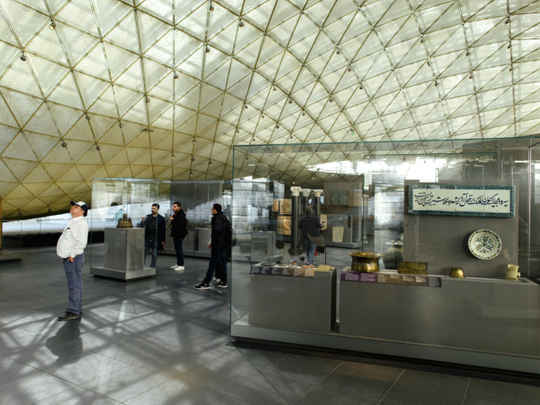
In Paris when you walk on the Right Bank of the Seine in the first arrondissement it is hard to miss a landmark that has come to define the city of eternal love. Louvre. With works of global cultural and artistic significance, Louvre houses artwork that spans the human civilisation and its very many epochs. On a rainy day, last year, I wended my way into the world’s largest art museum. There is a glass triangle made up of 666 lozenges and triangles (so I was told) in the courtyard of Louvre, just opposite the Jardin des Tuileries, to welcome you. For a moment you might be excused to believe that someone has whisked away the Pyramid of Giza all the way from Egypt and put it seductively in the lap of Louvre. The midsummer rain falling silently on Louvre’s majestic old French Renaissance architecture, glazed off the Pyramide du Louvre that morning, giving away a baroque contrast.
As you amble across the Napoleon hall, the stateliness of Louvre starts to hit you. This is the aggregation — the biggest, grandest, and most spectacular — of everything that mankind has achieved since the beginning of history. How does one envision the sheer scale of it? Artefacts from pre-history in one section to the ne plus ultra work from the masters of renaissance in another. To make it simpler, it is akin to the feeling of trotting away in paradise after you are dead. Like a wanderer, lost in some meadow of heaven, you are ensorcelled by the sculptures, objets d’art, paintings, masterpieces and multiple displays at Louvre. There are prints which are so priceless that no money can buy it, decorative arts of which there is no match, and gem stones that are known to sparkle even in a total solar eclipse. Anything that meets your eye squeaks out a multi-layered history of its own.
A treasure trove
Nearly 1800 years before Christ, the old Babylonians had prepared the first written economic formula in the world. Called the Law Code of Hammurabi, it is the longest surviving text from Old Babylon that is still extant. As one of the highlights of Louvre, it is almost 3800 years old (written in Akkadian language). You cannot but marvel at how the first dynasty of Babylon — modern day Iraq — developed a complete code for matters like blood feud, private retribution, and marriage by capture. Located in the ‘Near Eastern antiquities’ section at Louvre, Hammurabi’s code — the emblem of the Mesopotamian civilisation and one of humankind’s oldest deciphered writings — finds pride of place. I peered into the high basalt stele that was erected by the king of Babylon in the ancient city of Sippar on the bank of Euphrates. How much history was sponged up in those letters? In Paris, gaping at this piece of antiquity, 39 centuries later, I had no clue.
In the section that houses Italian paintings, Sandro Botticelli’s fresco Venus with Three Graces, made during 1483-1486, strikes out for its representation of linear grace of early Renaissance art. God knows how Louvre manages to fetch the best in the world and bring it under its roof but the story of Venus with Three Graces is interesting. Botticelli, who would firm up his reputation in the 16th century Europe as a genius of the Florentine School, made the fresco on the walls of Villa Lemmi, a country mansion near Florence owned by Giovanni Tornabuoni, a notable of Medici. It depicts a young woman, probably the owner, being received by Venus and the three Graces. Botticelli has shown Tornabuoni holding open a white cloth, into which Venus is laying roses that symbolise beauty and love. The artist went on to paint the Sistine Chapel in Rome, mastering the art of mythological paintings. Botticelli’s legacy of High Renaissance style artwork is an open treasure in the Louvre.
Talking of Italian maestros, perhaps no one supersedes the reputation of Leonardo da Vinci. A contemporary of Botticelli, Da Vinci was the ultimate Renaissance icon who excelled at whatever he touched. Known for his artistic prowess, scientific temper and technological ingenuity, his works are rivalled only by the likes of Michelangelo. Among his many creations, Mona Lisa — all of 77cm x 53cm — continues to capture the imagination of the world at large, and all those who visit the Louvre. It is no surprise then that all roads lead to the museum’s Salle des États, where the world’s most famous painting hangs behind a bullet proof glass. The portrait of a mysteriously smiling woman is so well-recognised that it has earned the distinction of being the most visited, the most written about, the most sung about, and the most parodied work of art in the world. Needless to say the world’s most valuable piece of art is supposed to be a portrait of Lisa Gherardini, wife of Francesco del Giocondo, a wealthy merchant of Florence. The oil on a white Lombardy poplar panel (painted between 1503 and 1506 by Da Vinci) has been on permanent display at the Louvre since 1797.
Like many others I was enamoured by Mona Lisa. Why is this rather smallish portrait so popular? Da Vinci has done many other great paintings (The Last Supper, The Vitruvian Man, Lady with an Ermine and so on and so forth) but why does no other work draw so much curiosity? Several other famous paintings use the same eye-catching painting technique, but why does everyone die to catch a glimpse of Mona Lisa? Some say it is an unfinished piece of work and Da Vinci wanted to keep it a secret, so why this brouhaha then? While it rained outside, I stood in front of Mona Lisa, drenched, looking straight in her eye in the climate-controlled room in Louvre. It was in that instant I reckoned what works for the painting is the sense of enigma that it preserves. The smile is whimsical, almost quizzical. The subject’s eyes seem to convey something deep and profound. You cannot say if she is young or old, melancholic or mischievous. On top of it Da Vinci was masterly in the monumentality of the composition and the atmospheric illusionism of Mona Lisa (called La Joconde in French). It was the first 3D portrait before 3D became hip. Relaxed and hypnotising that lends it an almost esoteric aura, the global appeal of Mona Lisa endures.
In the section that houses Hellenistic art, you can’t help but marvel at the Winged Victory of Samothrace. Though the sculpture is missing both its head and arms, it has long been considered to be one of the most moving pieces of art in Louvre. The statue of a winged female figure — the messenger deity Victory — stands on a base in the shape of the prow of a ship. Wearing a long chiton, or tunic, of fine cloth, that falls in folds to her feet, the figure was first found on the Greek island of Samothrace, and is thought to have been created around 200-190 BC. It has characteristics of Greek mythology — in which Nike was the deity of victory, who would fly down from Mount Olympus. Looking at the decorative richness of the artwork you can almost imagine the Winged Victory of Samothrace taking a flight.
A chequered history
In its rich history that spans more than 222 years, Louvre has gone to great lengths to save the rare masterpieces that adorn it. During the second World War the French did a great job in keeping the various works of art from falling into Nazi hands. People like Jacques Jaujard, director of France’s National Museums, were instrumental in keeping some of Louvre’s most prized possession, including the Mona Lisa, from destruction. As the German advance towards France became apparent, the French arranged convoys of trucks that carried more than a thousand crates of ancient and rare artefacts and hundreds of crates of some of the world’s most cherished paintings to the Loire Valley for safe keeping. How these works of art, criss-crossed the French countryside in the midst of Hitler’s assault is a great story in itself. We wouldn’t be able to see some of the greatest masterpieces like Michelangelo’s Dying Slave and Venus de Milo if it were not the great care and risk of the men and women who went out of the way in protecting the world’s shared legacy.
On my walk out of Louvre, I sat on a wooden bench by the Paul bakery. As I tucked into a hot croissant filled with pastry cream, I kept thinking about how Louvre brings us face-to-face with our past, our antiquity and awakens our cultural conscience in the most intense and passionate way.













